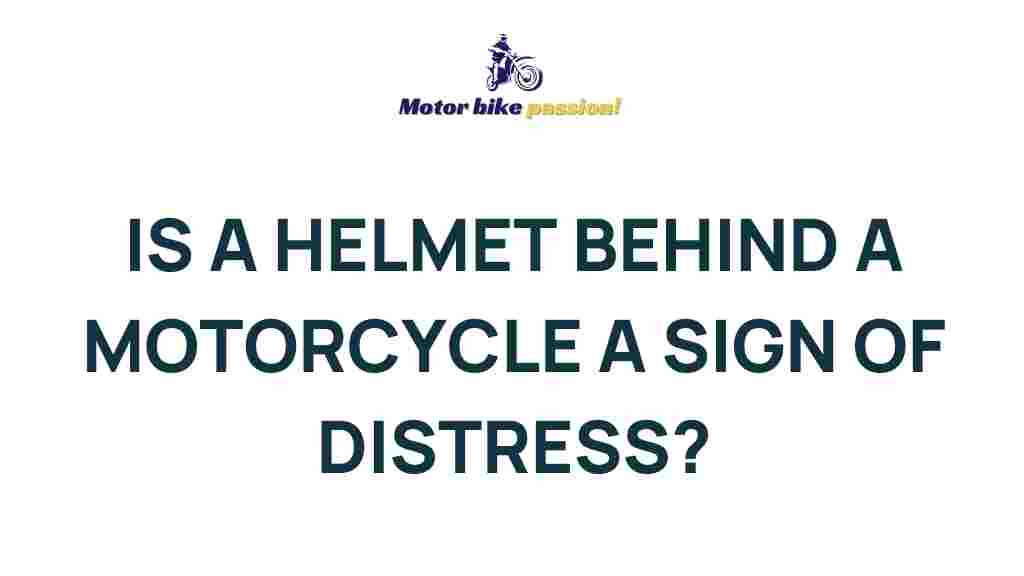Unveiling the Hidden Meanings of a Helmet Behind a Motorcycle
When we think of a motorcycle, the first image that often comes to mind is the rider clad in leather, speeding down an open road. However, one of the most significant elements that accompany this picture is the helmet. This crucial piece of gear is more than just a safety accessory; it carries a multitude of meanings that extend beyond its primary function. In this article, we will delve into the hidden meanings behind a helmet, exploring themes of safety, communication, distress, and road etiquette.
The Symbolism of a Helmet
The helmet serves as a powerful symbol in the motorcycling community. Here are some key aspects of its symbolism:
- Protection: At its core, a helmet represents safety. It is designed to protect the rider’s head in the event of an accident. This aspect is paramount, as it signifies a commitment to personal safety and the safety of others on the road.
- Identity: Helmets come in various styles, colors, and designs. They can reflect a rider’s personality, interests, and even their affiliations within the motorcycle community. A helmet can signify belonging to a group or subculture.
- Communication: The choice of helmet can communicate a rider’s attitude toward safety and risk. A flashy, decorative helmet might convey a sense of adventure, while a plain, utilitarian one may signal a focus on practicality.
Understanding Distress Signals
Motorcycle riding is not without its dangers, and the helmet can also symbolize distress in certain contexts. Recognizing the signs of distress among riders is crucial for road etiquette and safety.
- Body Language: A rider who appears tense or rigid may be in distress. If you observe a fellow motorcyclist struggling to maintain control, it’s essential to offer assistance.
- Helmet Damage: A damaged helmet can signify that the rider has been in an accident. Always check to see if a fellow rider needs help if you notice a helmet that appears compromised.
- Signals: Riders often use hand signals to communicate with each other on the road. A raised hand can indicate a need to stop or slow down, while a fist can communicate distress.
Helmet Safety: A Non-Negotiable Aspect of Motorcycling
In the world of motorcycling, safety is paramount. The helmet is the first line of defense against head injuries, making its proper use non-negotiable. Here’s a step-by-step guide on how to choose and use a helmet:
Step 1: Choosing the Right Helmet
When selecting a helmet, consider the following:
- Fit: A helmet should fit snugly but comfortably without being too tight. It should not move around when you shake your head.
- Type: There are various types of helmets, including full-face, modular, half, and open-face helmets. Each offers different levels of protection and visibility.
- Certification: Ensure the helmet meets safety standards set by organizations such as DOT (Department of Transportation) or Snell.
Step 2: Properly Wearing Your Helmet
To ensure maximum protection, follow these guidelines:
- Straps: Always buckle your helmet securely before riding. Loose straps can render the helmet ineffective.
- Visor: If your helmet has a visor, make sure it is clean and free of scratches to maintain visibility.
- Check for Damage: Before each ride, inspect your helmet for any signs of wear and tear. A compromised helmet should not be used.
Troubleshooting Common Helmet Issues
Even the best helmets can encounter issues. Here are some common problems and how to address them:
- Uncomfortable Fit: If your helmet feels uncomfortable after a short period, consider trying a different size or style. You may need to try on several helmets to find the best fit.
- Fogging Visor: If your visor fogs up, use anti-fog sprays or wipes. Alternatively, you can use a helmet with an anti-fogging feature.
- Noise: If your helmet is too noisy, check the fit again. Wind noise can often be reduced with a better-fitting helmet.
Road Etiquette: The Role of the Helmet
Road etiquette is crucial in ensuring safety for all riders. Here are some key points regarding how helmets play a role in communication and etiquette on the road:
- Visibility: Make sure your helmet is brightly colored or has reflective elements. This increases your visibility to other drivers, reducing the likelihood of accidents.
- Hand Signals: Use clear hand signals to communicate with other riders and drivers. For example, a left arm extended can indicate a left turn, while a closed fist can mean to stop.
- Group Riding: When riding in a group, ensure everyone is wearing a helmet. This not only promotes safety but also reinforces the importance of protection among peers.
Building a Community of Safety
Motorcyclists often form tight-knit communities. Promoting helmet use and road etiquette can help build a culture of safety and respect:
- Educate New Riders: Experienced riders should take the initiative to educate newcomers about the importance of helmets and safe riding practices.
- Organize Rides: Host group rides that emphasize safety, with a focus on proper helmet use and communication among riders.
- Share Experiences: Encourage riders to share their stories about how wearing a helmet saved their lives or prevented serious injury.
Conclusion
The helmet is an essential piece of equipment in the world of motorcycling, serving as a symbol of safety, communication, and community. It protects riders from potential harm while also conveying important messages about road etiquette and distress signals. By understanding the deeper meanings behind a helmet, we not only improve our own riding experience but also contribute to a safer and more respectful motorcycling culture. Always remember, wearing a helmet is not just about compliance; it’s about valuing your life and the lives of those around you on the road.
For further information about motorcycle safety and gear, visit this resource. To learn more about how to communicate effectively while riding, check out this article.
This article is in the category Safe Driving and created by MotorBikePassion Team
